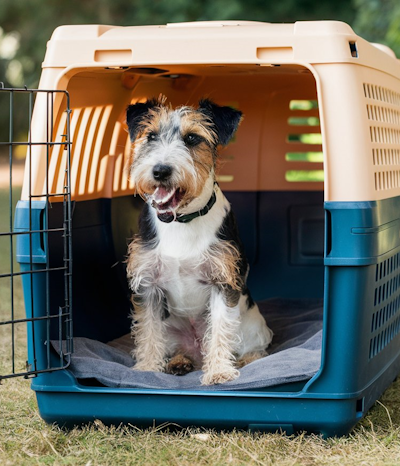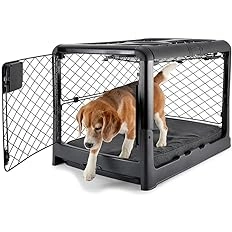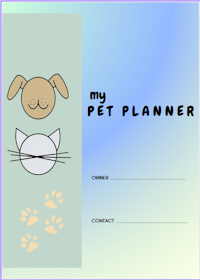Why A Dog Crate?
Because Every Dog Needs A Den!
In the modern world, the use of a dog crate aligns with the natural instinct imprinted on dogs from their origins to build a den. Thousands of years ago before dogs became man's companion, they roamed the land traveling in packs and built their own natural dens.
In the wild a dog's den was more or less, a burrow. Not very big inside, but closely surrounded by earth to provide shelter and a safe place to sleep away from predators.
Today's dog, by instinct, will be drawn to a crate as if it were a den. If introduced while still young, you will not have to coax your dog to make use of a crate - it will be natural for him to prefer this enclosed space for his naps and quiet times.
You will discover many situations when a dog crate is the perfect refuge for Rover and the perfect training tool for you. Since you will now become the leader of his pack, put some old clothing item of yours in the crate to reassure him that you are close by.
Dog Crates And Their Uses
- House training is the top use of a crate. Dogs in the wild don't soil their dens.
Dens are their refuge and sleeping quarters. They go outside of the den to take care of dog
business. So it makes sense that as soon as they associate a crate as their den, they will also
not want to soil it.
- Crates make house training a lot easier. While your dog is a young pup,
you will be taking him outside at regular intervals for bathroom breaks. If your dog doesn't get
the job done in a reasonable amount of time, you can put him in the crate for a short while and
then take him out again.
This isn't mean, it's a way to create successes for your dog so that you can praise him. After a while, he will learn the routine and you will learn more about his patterns.
- Company's Coming! That often means a lot of excitement for your dog and
sometimes visitors, including children, can be too stimulating. A perfect set-up for an accident!
- On the other hand, if Rover is finding the action a bit overwhelming, he can take cover in his dog crate.
Other Practical Uses For Dog Crates
- A crate will help your children learn that sometimes the dog needs a place he can time out for a break. Learning all the rules is tiring business!
- If you are going out for a short while to take care of some errands, the crate is a perfect place to leave Rover. Why set him up to get into mischief when you can leave him in his "den" feeling safe and secure until you return.
- Travel - going on a vacation or a just a long car ride. As an alternative to seat belts, a crate/carrier can come in very handy to give everyone their own space and make the drive safer.
- Taking a sick or injured pet to the vet is a perfect time for dog crates to keep everyone safe. The dog will feel more secure and if there are any messes, it's a lot easier to clean up.
After your dog becomes accustomed to his dog crate and associates it as his place, he will
automatically go there for naps and any time he just wants some quiet time.
It may also become his favorite place for overnight sleeping, especially if you move it to your bedroom when you
retire.
Guidelines For Dog Crate Use
Although crates are useful for training, don't ever banish your dog to the crate as a form of punishment. You want to make his den a safe haven and a place he enjoys. With this in mind, don't leave him in there for long periods of time with the door "closed".
Make sure he gets some good exercise and loving attention in between crate time, leaving
the door "open" so he can go there by choice whenever he wants.
You might even give him different
toys to play with or chew on while in his crate. This is especially helpful if you are meeting
with any resistance in your dog accepting the crate.
What Type of Dog Crates Do You Need?
Basically, you have two choices - wire crates or plastic crates, well three actually because there are also soft foldable crates. Just be aware when choosing a crate that the quality can vary quite a bit.
There are some advantages to steel wire crates:
- One is that your dog can't chew them and another is that they are usually collapsible for easy storage.
- Also, they have good ventilation and you can easily see what your dog is doing. Having said that, some are poorly made and are difficult to fold down without a struggle. In the long run, paying a little more will be worth it.
When you travel by air with your dog, plastic crates are
the way to go, as most of these are airline approved.
- But, regulations do vary between airlines regarding weight and size of crate allowed, so be sure to check that out before you buy.
- Basically an airline dog crate must be rigid and non-collapsible for air travel with secure doors, ventilation on four sides, and food/water trays accessible from the outside.
If you are mainly thinking of an in-the-home small crate for training a puppy, look for one that is adjustable.
- Many come with optional dividers so that you can adjust the size as your dog grows, saving you from buying a bigger one later on.
- Also, when you are house training your dog, you don't want any extra room where the dog could go potty. The natural instinct of a dog is not to soil his bed, so don't give him an en suite bathroom as well!
For all of you decorator types out there, many dog crates come with stylish covers in exotic
fabrics and matching interior bumpers and pads. And the great part is that the bedding and covers
are completely washable.
Before You Go...
If you like the content of this page, as well as others on my site, please give it some love by clicking on the heart in the lower right hand corner. This helps me to keep providing enjoyable and useful content.
Thank you.
Related Pages









